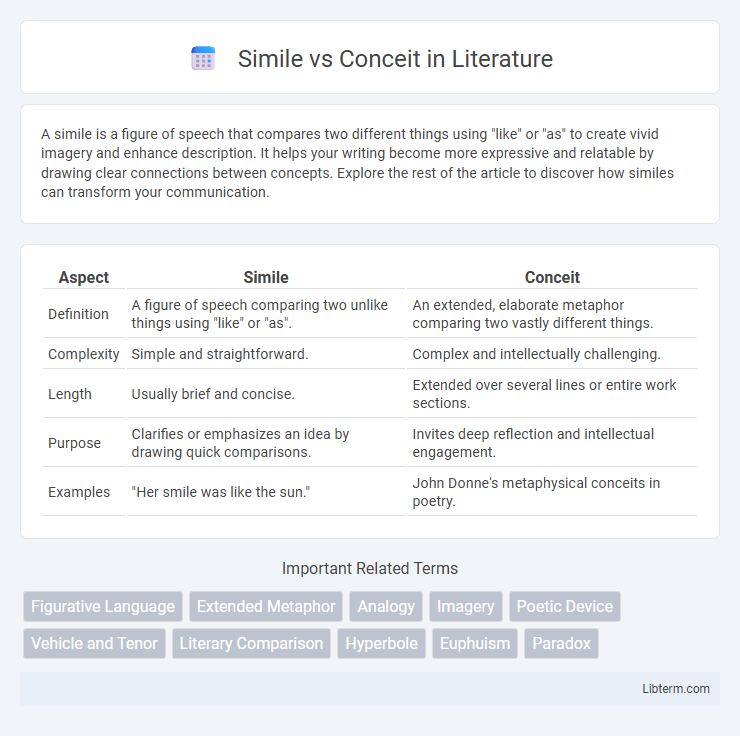A simile is a figure of speech that compares two different things using "like" or "as" to create vivid imagery and enhance description. It helps your writing become more expressive and relatable by drawing clear connections between concepts. Explore the rest of the article to discover how similes can transform your communication.
Table of Comparison
| Aspect | Simile | Conceit |
|---|---|---|
| Definition | A figure of speech comparing two unlike things using "like" or "as". | An extended, elaborate metaphor comparing two vastly different things. |
| Complexity | Simple and straightforward. | Complex and intellectually challenging. |
| Length | Usually brief and concise. | Extended over several lines or entire work sections. |
| Purpose | Clarifies or emphasizes an idea by drawing quick comparisons. | Invites deep reflection and intellectual engagement. |
| Examples | "Her smile was like the sun." | John Donne's metaphysical conceits in poetry. |
Understanding Simile: Basic Definition
A simile is a figure of speech that directly compares two different things using connecting words such as "like" or "as," highlighting their similarities in a clear and straightforward manner. It serves to create vivid imagery by linking an unfamiliar concept to a familiar one, making descriptions more relatable and engaging. Unlike a conceit, which is an elaborate and extended metaphor, a simile remains concise and accessible, commonly found in everyday language and poetry.
Unpacking Conceit: A Detailed Overview
Conceit is an extended and often elaborate comparison that goes beyond a simple simile by connecting two vastly different ideas in a surprising and thought-provoking way. It employs intricate metaphors that explore complex relationships, making it a prominent feature in metaphysical poetry and literary works. Unlike a straightforward simile, which uses "like" or "as" for brief comparisons, conceits create a sustained and layered metaphorical framework that enriches thematic depth and intellectual engagement.
Key Differences Between Simile and Conceit
Similes directly compare two unlike things using "like" or "as," creating clear and simple imagery for immediate understanding. Conceits are extended metaphors that draw complex, often surprising parallels between two seemingly unrelated concepts, requiring deeper interpretation. The key difference lies in similes' straightforwardness versus conceits' elaborate and intellectual nature.
Historical Origins of Simile and Conceit
Similes trace back to ancient literature, prominently used in Homeric epics where comparisons using "like" or "as" enhanced vivid imagery. Conceits emerged during the Renaissance, especially in metaphysical poetry, characterized by extended, elaborate metaphors that link seemingly unrelated concepts. Historical texts reveal simile's roots in everyday comparison, while conceits evolved as intellectual exercises in poetic expression during the 16th and 17th centuries.
Common Examples of Simile in Literature
Similes frequently appear in literature as vivid comparisons using "like" or "as," exemplified by Shakespeare's "as brave as a lion" in *Henry VI* and Robert Burns' "My love is like a red, red rose." Unlike conceits, which are extended and elaborate metaphors, similes provide brief, clear imagery to enhance understanding. Classic examples include Emily Dickinson's "Hope is the thing with feathers" and Langston Hughes' "Life is like a broken-winged bird."
Famous Conceits in Classic Poetry
Famous conceits in classic poetry often include John Donne's comparison of two lovers to the two legs of a compass in "A Valediction: Forbidding Mourning," illustrating an extended metaphor that bridges complex emotional and intellectual ideas. Another notable example is Andrew Marvell's use of the flea in his poem "The Flea," where the insect becomes a symbol for seduction and intimacy, blending wit with philosophical depth. These conceits distinguish themselves from simple similes by weaving intricate, unconventional analogies that engage the reader in deeper interpretive layers beyond straightforward comparisons.
Functions and Effects of Similes in Writing
Similes function to create vivid imagery and clarify complex ideas by drawing explicit comparisons between two unlike things using "like" or "as," enhancing readers' understanding and engagement. They evoke sensory experiences and emotional responses, making descriptions more relatable and memorable. Similes also add rhythm and musicality to writing, contributing to the overall aesthetic and helping to convey tone and mood effectively.
The Art of Crafting Powerful Conceits
Similes create vivid imagery by comparing two different things using "like" or "as," while conceits develop more intricate, extended metaphors that link seemingly unrelated ideas in surprising ways. Mastering the art of crafting powerful conceits involves blending imagination with intellectual engagement, often resulting in thought-provoking and memorable expressions. Poets like John Donne exemplify this skill by using elaborate conceits that challenge readers to explore deeper symbolic meanings beyond surface comparisons.
Simile vs Conceit: When to Use Each Device
Similes use explicit comparisons with "like" or "as" to clarify or emphasize a point by making descriptions more relatable and accessible, ideal for straightforward imagery. Conceits employ extended, often elaborate metaphors that create complex and surprising connections, best suited for sophisticated or intellectual contexts where deeper reflection is desired. Choose similes for clarity and immediacy, while conceits fit when aiming to provoke thought and highlight creativity in literary or poetic works.
Enhancing Creativity: Blending Simile and Conceit
Blending simile and conceit enhances creativity by merging straightforward comparisons with elaborate, imaginative metaphors, expanding expressive possibilities. Similes use "like" or "as" to create vivid, relatable images, while conceits develop extended, often surprising analogies that challenge conventional thinking. Combining these techniques fosters innovative storytelling and deepens the emotional impact of language in poetry and prose.
Simile Infographic

 libterm.com
libterm.com